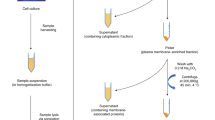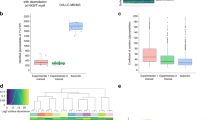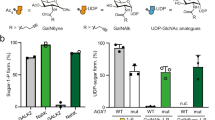Abstract
Although the classification of cell types often relies on the identification of cell surface proteins as differentiation markers, flow cytometry requires suitable antibodies and currently permits detection of only up to a dozen differentiation markers in a single measurement. We use multiplexed mass-spectrometric identification of several hundred N-linked glycosylation sites specifically from cell surface–exposed glycoproteins to phenotype cells without antibodies in an unbiased fashion and without a priori knowledge. We apply our cell surface–capturing (CSC) technology, which covalently labels extracellular glycan moieties on live cells, to the detection and relative quantitative comparison of the cell surface N-glycoproteomes of T and B cells, as well as to monitor changes in the abundance of cell surface N-glycoprotein markers during T-cell activation and the controlled differentiation of embryonic stem cells into the neural lineage. A snapshot view of the cell surface N-glycoproteins will enable detection of panels of N-glycoproteins as potential differentiation markers that are currently not accessible by other means.
This is a preview of subscription content, access via your institution
Access options
Subscribe to this journal
Receive 12 print issues and online access
$209.00 per year
only $17.42 per issue
Buy this article
- Purchase on Springer Link
- Instant access to full article PDF
Prices may be subject to local taxes which are calculated during checkout






Similar content being viewed by others
Change history
09 September 2009
In the version of this article initially published, in Methods, p.385, line 5, the concentration of MgCl2, given as 0.5 M, is incorrect. The correct concentration is 0.5 mM MgCl2.The error has been corrected in the HTML and PDF versions of the article.
References
von Heijne, G. The membrane protein universe: what's out there and why bother? J. Intern. Med. 261, 543–557 (2007).
Wollscheid, B. et al. Lipid raft proteins and their identification in T lymphocytes. Subcell. Biochem. 37, 121–152 (2004).
Hosen, N. et al. CD96 is a leukemic stem cell-specific marker in human acute myeloid leukemia. Proc. Natl. Acad. Sci. USA 104, 11008–11013 (2007).
Hopkins, A.L. & Groom, C.R. The druggable genome. Nat. Rev. Drug Discov. 1, 727–730 (2002).
Stewart, C.C. & Nicholson, J.K.A. Immunophenotyping (Wiley-Liss, New York, 2000).
Zola, H. et al. CD molecules 2006—human cell differentiation molecules. J. Immunol. Methods 319, 1–5 (2007).
Zola, H. Medical applications of leukocyte surface molecules—the CD molecules. Mol. Med. 12, 312–316 (2006).
Ahram, M., Litou, Z.I., Fang, R. & Al-Tawallbeh, G. Estimation of membrane proteins in the human proteome. In Silico Biol. (Gedrukt) 6, 379–386 (2006).
Nicholson, I.C., Ayhan, M., Hoogenraad, N.J. & Zola, H. In silico evaluation of two mass spectrometry-based approaches for the identification of novel human leukocyte cell-surface proteins. J. Leukoc. Biol. 77, 190–198 (2005).
Craig, F.E. & Foon, K.A. Flow cytometric immunophenotyping for hematologic neoplasms. Blood 111, 3941–3967 (2008).
Evans, E.J. et al. The T cell surface—how well do we know it? Immunity 19, 213–223 (2003).
Aebersold, R. & Mann, M. Mass spectrometry-based proteomics. Nature 422, 198–207 (2003).
Bantscheff, M., Schirle, M., Sweetman, G., Rick, J. & Kuster, B. Quantitative mass spectrometry in proteomics: a critical review. Anal. Bioanal. Chem. 389, 1017–1031 (2007).
Macher, B.A. & Yen, T.Y. Proteins at membrane surfaces—a review of approaches. Mol. Biosyst. 3, 705–713 (2007).
Josic, D. & Clifton, J.G. Mammalian plasma membrane proteomics. Proteomics 7, 3010–3029 (2007).
Pasini, E.M. et al. In-depth analysis of the membrane and cytosolic proteome of red blood cells. Blood 108, 791–801 (2006).
Andersen, J.S. & Mann, M. Organellar proteomics: turning inventories into insights. EMBO Rep. 7, 874–879 (2006).
Han, D.K., Eng, J.K., Zhou, H. & Aebersold, R. Quantitative profiling of differentiation-induced microsomal proteins using isotope-coded affinity tags and mass spectrometry. Nat. Biotechnol. 19, 946–951 (2001).
Nunomura, K. et al. Cell surface labeling and mass spectrometry reveal diversity of cell surface markers and signaling molecules expressed in undifferentiated mouse embryonic stem cells. Mol. Cell. Proteomics 4, 1968–1976 (2005).
Rybak, J.N. et al. In vivo protein biotinylation for identification of organ-specific antigens accessible from the vasculature. Nat. Methods 2, 291–298 (2005).
Zhang, W., Zhou, G., Zhao, Y., White, M.A. & Zhao, Y. Affinity enrichment of plasma membrane for proteomics analysis. Electrophoresis 24, 2855–2863 (2003).
Arnott, D. et al. Selective detection of membrane proteins without antibodies: a mass spectrometric version of the Western blot. Mol. Cell. Proteomics 1, 148–156 (2002).
Lewandrowski, U., Moebius, J., Walter, U. & Sickmann, A. Elucidation of N-glycosylation sites on human platelet proteins: a glycoproteomic approach. Mol. Cell. Proteomics 5, 226–233 (2006).
Kaji, H., Yamauchi, Y., Takahashi, N. & Isobe, T. Mass spectrometric identification of N-linked glycopeptides using lectin-mediated affinity capture and glycosylation site-specific stable isotope tagging. Nat. Protocols 1, 3019–3027 (2006).
Wu, C.C., MacCoss, M.J., Howell, K.E. & Yates, J.R. A method for the comprehensive proteomic analysis of membrane proteins. Nat. Biotechnol. 21, 532–538 (2003).
Elortza, F. et al. Proteomic analysis of glycosylphosphatidylinositol-anchored membrane proteins. Mol. Cell. Proteomics 2, 1261–1270 (2003).
Watarai, H. et al. Plasma membrane-focused proteomics: dramatic changes in surface expression during the maturation of human dendritic cells. Proteomics 5, 4001–4011 (2005).
Zhang, H., Li, X.J., Martin, D.B. & Aebersold, R. Identification and quantification of N-linked glycoproteins using hydrazide chemistry, stable isotope labeling and mass spectrometry. Nat. Biotechnol. 21, 660–666 (2003).
Varki, A., Cummings, R. & Esko, J. Essentials of Glycobiology (Cold Spring Harbor Laboratory Press, Cold Spring Harbor Press, NY, 2002).
Bayer, E.A., Ben-Hur, H. & Wilchek, M. Biocytin hydrazide—a selective label for sialic acids, galactose, and other sugars in glycoconjugates using avidin-biotin technology. Anal. Biochem. 170, 271–281 (1988).
Gahmberg, C.G. & Andersson, L.C. Selective radioactive labeling of cell surface sialoglycoproteins by periodate-tritiated borohydride. J. Biol. Chem. 252, 5888–5894 (1977).
Yates, J.R., Eng, J.K. & McCormack, A.L. Mining genomes: correlating tandem mass spectra of modified and unmodified peptides to sequences in nucleotide databases. Anal. Chem. 67, 3202–3210 (1995).
Keller, A., Eng, J., Zhang, N., Li, X.J. & Aebersold, R. A uniform proteomics MS/MS analysis platform utilizing open XML file formats. Mol. Syst. Biol. 1, 2005.0017 (2005).
Nesvizhskii, A.I., Keller, A., Kolker, E. & Aebersold, R. A statistical model for identifying proteins by tandem mass spectrometry. Anal. Chem. 75, 4646–4658 (2003).
Shannon, P. et al. Cytoscape: a software environment for integrated models of biomolecular interaction networks. Genome Res. 13, 2498–2504 (2003).
North, S.J. et al. Glycomic studies of Drosophila melanogaster embryos. Glycoconj. J. 23, 345–354 (2006).
Thomas, P.D. et al. PANTHER: a browsable database of gene products organized by biological function, using curated protein family and subfamily classification. Nucleic Acids Res. 31, 334–341 (2003).
Krogh, A., Larsson, B., von Heijne, G. & Sonnhammer, E.L. Predicting transmembrane protein topology with a hidden Markov model: application to complete genomes. J. Mol. Biol. 305, 567–580 (2001).
Schamel, W.W. & Reth, M. Monomeric and oligomeric complexes of the B cell antigen receptor. Immunity 13, 5–14 (2000).
Sancho, D., Gomez, M. & Sanchez-Madrid, F. CD69 is an immunoregulatory molecule induced following activation. Trends Immunol. 26, 136–140 (2005).
Kim, J.E. & White, F.M. Quantitative analysis of phosphotyrosine signaling networks triggered by CD3 and CD28 costimulation in Jurkat cells. J. Immunol. 176, 2833–2843 (2006).
Schiess, R. et al. Analysis of cell surface proteome changes via label-free, quantitative mass spectrometry. Mol. Cell Proteomics published online, doi:10.1074/mcp.M800172-MCP200 (25 November 2008).
Bibel, M. et al. Differentiation of mouse embryonic stem cells into a defined neuronal lineage. Nat. Neurosci. 7, 1003–1009 (2004).
Bibel, M., Richter, J., Lacroix, E. & Barde, Y. Generation of a defined and uniform population of CNS progenitors and neurons from mouse embryonic stem cells. Nat. Protocols 2, 1034–1043 (2007).
Mueller, L.N. et al. SuperHirn—a novel tool for high resolution LC-MS-based peptide/protein profiling. Proteomics 7, 3470–3480 (2007).
Jarvis, D.L. Developing baculovirus-insect cell expression systems for humanized recombinant glycoprotein production. Virology 310, 1–7 (2003).
Aumiller, J.J., Hollister, J.R. & Jarvis, D.L. A transgenic insect cell line engineered to produce CMP-sialic acid and sialylated glycoproteins. Glycobiology 13, 497–507 (2003).
Viswanathan, K. et al. Engineering sialic acid synthetic ability into insect cells: identifying metabolic bottlenecks and devising strategies to overcome them. Biochemistry 42, 15215–15225 (2003).
Chivian, D. et al. Automated prediction of CASP-5 structures using the Robetta server. Proteins 53 (Suppl 6), 524–533 (2003).
Martin, D., Wollscheid, B., Aebersold, R. & Watts, J. Methods for characterizing glycoproteins and generating antibodies for same. US Patent 066661-0148 (2008).
Acknowledgements
This work has been funded in part with federal funds from the National Heart, Lung, and Blood Institute, National Institutes of Health (NIH), under contract no. N01-HV-28179 (to R.A.), from NIH RO1-AI51344-01 (to J.D.W.), from NIH N01-HV-28179-22 (to B.W.) and from National Center of Competence in Research (NCCR) Neural Plasticity and Repair (to B.W.). Thanks to Anne-Claude Gingras and Peter Zandstra for critical reading of the manuscript; to Andreas Hofmann and Thomas Bock for supplying information and graphics support; to Alexander Schmidt for LTQ-FT performance; and to Jimmy Eng, Andy Keller, Alexey Nesvizhskii, David Shteynberg, Luis Mendoza, Josh Tasman, James Eddes, Andreas Panagiotidis and Patrick Pedrioli for bioinformatic support.
Author information
Authors and Affiliations
Contributions
B.W., R.A. and J.D.W. planned the project. B.W., C.H., D.B.-F., M.B. and R.O. carried out experimental work. R.S. carried out the Drosophila experiments. B.W. and D.B.-F. analyzed the data. B.W., R.A. and J.D.W. wrote the paper. All authors discussed the results and commented on the manuscript.
Corresponding author
Supplementary information
Supplementary Figures
Supplementary Figures 1–4 (PDF 1152 kb)
Supplementary Table 1
CSC identified Jurkat T lymphocyte proteins (XLS 45 kb)
Supplementary Table 2
CSC identified Jurkat T lymphocyte glycoproteins upon initial Neuramidase treatment (XLS 49 kb)
Supplementary Table 3
CSC identified Kc167 cell proteins (XLS 38 kb)
Supplementary Table 4
CSC identified Kc167 cell peptides (XLS 50 kb)
Supplementary Table 5
CSC identified Jurkat T lymphocyte peptides (XLS 70 kb)
Supplementary Table 6
CSC identified mouse splenocyte proteins (XLS 39 kb)
Supplementary Table 7
CSC identified mouse splenocyte peptides (XLS 68 kb)
Supplementary Table 8
CSC identified and quantified human Ramos and Jurkat lymphocyte proteins (XLS 47 kb)
Supplementary Table 9
CSC identified human Ramos and Jurkat lymphocyte peptides (XLS 63 kb)
Supplementary Table 10
CSC identified and quantified proteins from unstimulated and CD3/CD28 stimulated human Jurkat T lymphopcytes (XLS 55 kb)
Supplementary Table 11
CSC identified peptides from unstimulated and CD3/CD28 stimulated human Jurkat T lymphopcytes (XLS 187 kb)
Supplementary Table 12
CSC identified proteins from embryonic stem cell, embroid bodies and neural precursors (XLS 185 kb)
Supplementary Table 13
CSC identified peptides from embryonic stem cell, embroid bodies and neural precursors (XLS 322 kb)
Rights and permissions
About this article
Cite this article
Wollscheid, B., Bausch-Fluck, D., Henderson, C. et al. Mass-spectrometric identification and relative quantification of N-linked cell surface glycoproteins. Nat Biotechnol 27, 378–386 (2009). https://doi.org/10.1038/nbt.1532
Received:
Accepted:
Published:
Issue Date:
DOI: https://doi.org/10.1038/nbt.1532
This article is cited by
-
Organelle resolved proteomics uncovers PLA2R1 as a novel cell surface marker required for chordoma growth
Acta Neuropathologica Communications (2024)
-
The proteome of the blood–brain barrier in rat and mouse: highly specific identification of proteins on the luminal surface of brain microvessels by in vivo glycocapture
Fluids and Barriers of the CNS (2024)
-
sBioSITe enables sensitive identification of the cell surface proteome through direct enrichment of biotinylated peptides
Clinical Proteomics (2023)
-
A CRISPR-engineered isogenic model of the 22q11.2 A-B syndromic deletion
Scientific Reports (2023)
-
Surfaceome mapping of primary human heart cells with CellSurfer uncovers cardiomyocyte surface protein LSMEM2 and proteome dynamics in failing hearts
Nature Cardiovascular Research (2023)



